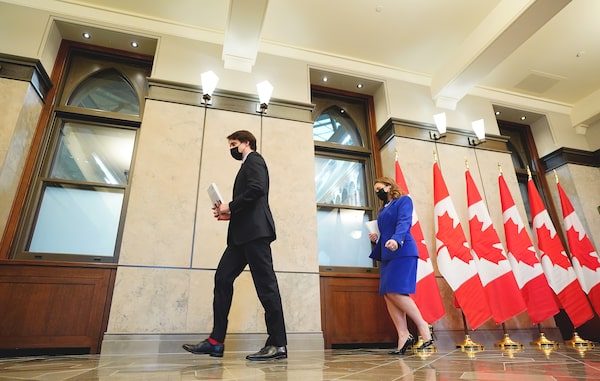
Finance Minister and Deputy Prime Minister Chrystia Freeland and Prime Minister Justin Trudeau leave a press conference before the release of the federal budget, on Parliament Hill, in Ottawa, Thursday, April 7, 2022.Sean Kilpatrick/The Canadian Press
This week’s federal budget was a timely reminder that Ottawa is still a little fuzzy – maybe even dangerously fuzzy – on what a fiscal anchor really is.
“We are absolutely determined that our debt-to-GDP ratio must continue to decline. Our pandemic deficits are and must continue to be reduced. The extraordinary debts we incurred to keep Canadians safe and solvent must be paid down. This is our fiscal anchor,” Deputy Prime Minister and Finance Minister Chrystia Freeland said in the preamble to a budget that, for the next 300 pages, displayed a less-than-absolute commitment to those goals.
The budget shrinks the pandemic-bloated deficit considerably, but nowhere near as much as it easily could have. Where it could sop up more red ink, it finds new ways to spend. The federal debt-to-gross-domestic-product ratio is headed in the right direction, but on a pace that will leave it still far above its pre-pandemic level a decade from now – and that’s if we have the incredible luck to avoid serious economic shocks along the way.
Despite pledging its determination to reverse the fiscal damage from the pandemic, the Liberal government continues to define this commitment by a “fiscal anchor” (its term of choice) that, really, isn’t much of an anchor at all. Its promise – to reverse COVID-19-related deficits and reduce the debt-to-GDP ratio “over the medium term” – merely points in a direction, with neither a specific destination nor a specific timeline.
Federal budget hits mark with enough funding to meet record-setting immigration levels
For the better part of two decades under the governments of Jean Chrétien, Paul Martin and Stephen Harper, the country had about as firm a fiscal anchor as we’ve ever had: The goal was a balanced budget. While one could argue with the value of maintaining such a conservative target, there was little doubt of the clarity and fiscal discipline it engendered.
When the Liberals under Justin Trudeau won the 2015 election, it was on a pledge to run modest, temporary deficits to address long-neglected infrastructure investment, with a goal of returning to balance within four years. Before long, though, the government abandoned balance as the anchor for fiscal policy, instead latching onto gradually declining debt-to-GDP as its goal.
That may have been enough before the pandemic, when the country was dealing with a debt-to-GDP ratio of 31 per cent, and falling. Now, it’s 46.5 per cent.
Many economists argue that the current flimsy anchor is not nearly specific enough to instill serious discipline to buckle down and reverse the fiscal damage from the pandemic. It allows the government too much room to equivocate, to delay, to take its eye off the ball every time it sees a new pet program it wants to fund.
The numbers in this budget show what they mean.
By the government’s own reckoning, the COVID-19 emergency has passed. And yet the deficit, while shrinking, is more than $30-billion larger than in the last pre-COVID budget.
With little effort, the government could have reduced its deficit more quickly, but it chose not to. The budget revealed that the projected deficit for 2022-2023 had improved by $14.3-billion over its December projection. It then immediately outlined additional spending plans to eat up more than half of those gains.
Budget projections anticipate that the deficit is four years away from returning to pre-pandemic levels. Debt-to-GDP at that point will be 43 per cent – modestly lower than it is today, but about 12 percentage points higher than it was before the pandemic.
And that’s if everything goes relatively well.
The budget considers an alternative scenario – not its base case, but, nevertheless, an entirely plausible one – in which the war in Ukraine is a drawn-out crisis that deepens and prolongs supply-chain disruptions, chokes off Russian oil and gas exports, further escalates commodity prices, and forces central banks to raise interest rates higher and faster to quell inflation. In that case, it projects deficits lingering around 1.5 per cent of GDP for the next several years – about double where they were before the pandemic – in an economic climate that could well teeter on recession.
Frankly, if Canada heads into another serious recession with deficits still north of 1.5 per cent of GDP, we have a problem. The government faces the prospect of heading into this next battle without having adequately recovered its financial wounds from the last one. That will either limit its ability to help the country weather a recession, or plunge its debts into new and more problematic depths trying. Maybe both.
The budget’s projections paint a happy picture of a deficit of a puny $8.4-billion five years from now (notably, beyond the current government’s mandate). But even before the ink had dried on those figures, Ms. Freeland said that future budgets would roll out more of the Liberals’ campaign promises. It was, effectively, an admission that the rosy deficit projections aren’t safe from the government that made them.
The Liberals can delude themselves that their fiscal anchor will give them the discipline not to stray too far toward their worst big-spending instincts, and keep them focused on mending the pandemic’s fiscal damage. It won’t. For the task at hand, it’s not nearly enough.
 David Parkinson
David Parkinson